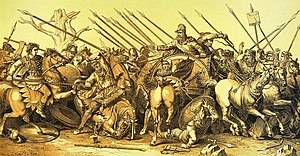Alexander Mosaic
The mosaic is believed to be a copy of a late 4th or early 3rd-century BC Hellenistic painting, perhaps by Philoxenus of Eretria or Apelles.
[6] It stands out among ancient works of art because it represents a large group of soldiers, depicts each figure with meticulous attention to detail, expertly captures the expressions that appear on the warriors' faces, and uses muted colors.
Alexander wears a linen breastplate, or linothorax, with the head of Medusa, the traditional emblem of Athena, and he rides his horse Bucephalus.
At this precise moment, Darius is making the order, because the Persian spears are still pointed in the direction of the Greeks, and the king is riding in a chariot being wheeled around.
Radical foreshortening—as in the central horse, seen from behind—and the use of shading to convey a sense of mass and volume enhance the naturalistic effect of the scene.
At the same time, action is arrested by dramatic details such as the fallen horse and the Persian soldier in the foreground who watches his own death throes reflected in a shield.
The mosaic is made of about one and a half million tiny colored tiles called tesserae, arranged in gradual curves called opus vermiculatum (also known as worm work, because they seem to replicate the slow motion of a crawling worm)[8] rather than opus signinum or other forms of stone chips put in mortar.
The process of gathering materials for mosaics was a complex undertaking since the color scale was based solely on the pieces of marble that could be found in nature.
[13] Since the mosaic was arranged on the floor where the patron could receive guests, it was the first decorative object a visitor would see upon entering that room.
[15] Similar to Greek paintings, the mosaic of Alexander the Great lacks rich iconography towards the top, which, on a vertical surface, would have been considerably higher above the viewer's line of sight and garnered less creative attention.
As a bonus, the mosaic displays the realism and naturalism typical of Greek portrayals of humans, especially regarding facial expression, emotional tone, and anatomical structure.
[11] It is a commonly accepted belief concerning the Alexander mosaic that one must use the Greek original to interpret the meaning of the Roman copy.
[8] The debate among scholars over the significance of the Roman copy is that it cannot and should not be interpreted in the same cultural and historical context as the Greek original.
The mosaic is held to be a copy either of a painting by Aristides of Thebes, or of a lost late 4th-century BC fresco by the painter Philoxenus of Eretria.
In January 2021 the National Archaeological Museum of Naples began a major restoration project to attempt to conserve the mosaic.
In the initial assessment of the mosaic, multiple issues were discovered, including detached tesserae, cracks, bulges and surface depressions.
[21] Some areas had been already treated, such as multiple cracks that had been covered by thin paper bandages in a "velinatura" technique, in prior restoration efforts.
[4] The first peristyle dominates the house not only visually and functionally, but it also commands the design, determining the locations and the dimensions of the other major parts.
[4] The room is so strategically placed that it would not be an exaggeration to say that the rest of the house had been designed and built around the site with the great treasure of mosaic art set in its floor.
[4] A major renovation phase beginning c. 110 BC and ending c. 75 BC comprised a new decoration in the so-called First Style (including all the well-known mosaic pavements), as well as the insertion of a second entrance into the tetrastyle atrium, a switch from Doric to Ionic in the portico of the small peristyle, and the construction of the large north peristyle.
"[24] Eight pictorial mosaics were laid in the House of the Faun as part of a major renovation program of the early first century BC.

